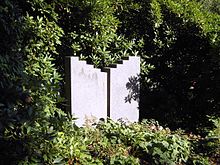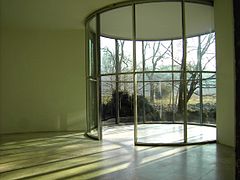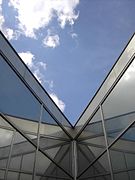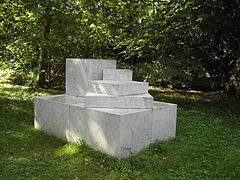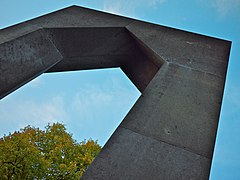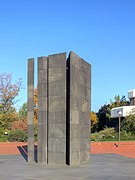Erwin Heerich
Erwin Heerich (born November 29, 1922 in Kassel ; † November 6, 2004 in Meerbusch- Osterath) was a German artist .
biography
Erwin Heerich was born in Kassel in 1922 and spent his childhood there. While still a high school student, he studied with a municipal scholarship as a guest student at the Kunstgewerbeschule Kassel and completed an apprenticeship in a pottery in Hannoversch Münden . In 1941 he was drafted into the war and released in 1945 after being wounded several times.
As early as 1945 he resumed his artistic studies and from 1945 to 1950 he attended the State Art Academy in Düsseldorf in the sculpture class of Ewald Mataré . From 1950 to 1954 he had the master class atelier there together with Joseph Beuys and began independent artistic work. At this time, stylized animal sculptures, figurines and the first drawings of plants and objects that were integrated into a tracery system were created.
In 1950 he married Hildegard Müller, with whom he had four children. Since 1953 he lived in Meerbusch-Büderich, in 1964 he moved with his family to Meerbusch-Osterath, where he lived until his death.
In 1954 he left the art academy and continued to work as a freelance artist and teacher. In 1957 he became Mataré's assistant at Oskar Kokoschka's summer academy in Salzburg . From 1959 cardboard sculptures and drawings, prints and graphics were created in the free area of isometric law. In 1961 he got a job as a teacher at the seminar for working education in Düsseldorf . In 1968 Heerich was represented with 10 cardboard sculptures at the 4th documenta in Kassel .
In 1969 he was appointed to the Art Academy in Düsseldorf , where he was professor until his retirement in 1988 . From 1974 Heerich was a member of the Berlin Academy of the Arts . In 1978 he received the Will Grohmann Prize in Berlin for his work . In 1980 he began planning the buildings on the Museum Island Hombroich near Neuss and also created numerous sculptural works in public spaces.
In 1987 he received the Max Beckmann Prize from the city of Frankfurt am Main . In 1989 the sculpture Monument was created from Eifel basalt lava for the Viersen sculpture collection . In 1995 he was a recipient of the Stankowski Foundation . For his place of residence in Meerbusch he designed two sculptures made of African granite: The bank in Büderich (2000) and a sculpture o. T. (so-called chair ) for the Rathauspark in Osterath (2003).
Heerich died on November 6, 2004 after a long illness at the age of 81 in Meerbusch-Osterath near Düsseldorf .

Meaning, work and career
Erwin Heerich is one of the most important German sculptors of the second half of the 20th century. This reflects the response to his death in November 2004 in the national and international press. His works can be found in major museums and collections of modern sculpture.
As a student of Ewald Mataré at the Düsseldorf Art Academy, he developed a completely independent sculptural work in the 1950s, always remaining true to his individual artistic line and never allowing himself to be absorbed by the “zeitgeist”. As a two-time documenta participant, he received international attention. In addition to Europe, he was represented at exhibitions in New York and Tokyo, in Cairo and at the Biennale in Sao Paulo. From 1968 to 1982 he taught as a professor at the Düsseldorf Art Academy. As an academic teacher and colleague who likes to discuss, he was one of the most influential personalities here for many years.
Heerich's work was based on everyday objects such as animals, trees, jointed dolls, chairs and umbrellas. But for him it was never about the mimetic representation of the external world, he was always only interested in the architectural, as he himself described his plastic concept in an interview with Heinz-Norbert Jocks.
At the beginning of his artistic activity, Mataré influenced works with a clear reference to the world of objects. Around 1960 he simplified his sculptures more and more and developed geometric bodies from figures, natural phenomena and everyday objects, all of which are subject to a certain measure and can be regulated solely by units of measure. As a material, he initially preferred brown cardboard. In the course of the 1960s and 1970s, Heerich created a repertoire of shapes with the help of his drawings and cardboard sculptures, from which he drew again and again until the end of his life. Christoph Brockhaus described this very own artistic world as the “universe of spatial bodies”. The clarity of the concept allows each design to be implemented in a wide variety of sizes and techniques.
Heerich's special artistic achievement is the discovery of the banal material “cardboard” as a material for sculptures. From this transitory and actually worthless material he created sculptures of timeless validity. The geometrically exact cardboard sculptures became Heerich's trademark. They are based on corresponding drawings. Although his work is based on mathematical logic, intuition plays an important role for Heerich. His rational-looking sculptures often turn into the irrational. Because his geometrical and sterometric drawings and structures are often so complicated that the viewer can no longer see through them rationally, but can only grasp them in their sensual appearance. The first cardboard sculptures of “dolls chairs”, horses and figures on the beach reveal another facet in Heerich's being: humor and immediate joy in playing.
In the catalog for the Biennale in Sao Paulo, Erwin Heerich described his artistic concept: "The duration of my project is not in the area of the made, but of the thought". This means that his ideas can be implemented in a wide variety of materials and dimensions.
He got the opportunity to do so in the early 1980s. At that time, he designed several buildings on the Museum Island Hombroich near Neuss and realized them in collaboration with the Düsseldorf architect Hermann H. Müller and the art collector and real estate agent Karl-Heinrich Müller . Heerich viewed these buildings as accessible sculptures. With them he has brought together pure form, uncompromising puristic beauty and practical application. He understood how to translate the ideas of the Bauhaus artists of the 1920s into a language of his own. Starting with the simplest basic geometric shapes such as circles, rectangles and squares, pavilions were created as decentralized exhibition spaces for Karl-Heinrich Müller's collections.
"Tower" and "Graubner Pavilion" are not equipped. As architecture of perfect harmony, they are among the most beautiful buildings of the modern age in the professional world and with the public. With their clinker walls, they fit perfectly into the nature of the Museum Island. Heerich's architecture, the artificial forms, are in dialogue with the landscape, nature and light. The sculptural architecture has an inconspicuous outer skin, but inside, the simple, perfectly proportioned white rooms develop their convincing aesthetic effect.
Erwin Heerich's name is inextricably linked with the cardboard sculptures and the total work of art Museum Insel Hombroich . He had his studio here for many years. His estate was transferred to the Insel Hombroich Foundation. After processing the estate, the Erwin Heerich Archive was opened in March 2010 in the Siza pavilion on the neighboring missile station with the Erwin Heerich exhibition . Processes of plastic thinking opened up and made accessible to the public. Heerich also designed several buildings for the rocket station, such as the Fontana House.
Heerich created numerous sculptures for public and private clients. With his high artistic standards, he did not compromise on the placement of his sculptures. In contrast to the postmodern understanding, he opposed the complexity of modern life with a unified artistic principle. In doing so, he set standards and standards in the artistic landscape of the second half of the 20th century, not only in the Museum Insel Hombroich, but with all of his work.
Exhibitions (selection)
E = solo exhibition
- 1964: van der Grinten, Kranenburg (E)
- 1966: Galerie Schmela , Düsseldorf (E)
- 1967: Municipal Museum Abteiberg , Mönchengladbach (E)
- 1968: Dwan gallery, New York (E)
- 1968: documenta 4 , Kassel
- 1970: Kunsthalle Cologne
- 1972: Art Association for the Rhineland and Westphalia , Düsseldorf (E)
- 1973: XII Bienal de Sao Paulo, Brazil
- 1974: Rheinisches Landesmuseum Bonn (E)
- 1976: Art Association Freiburg (E)
- 1977: documenta 6 , Kassel
- 1979: Academy of the Arts, Berlin; Kestner Society, Hanover; Museum Nijmegen; Museum Haus Lange, Krefeld
- 1980: Morsbroich Castle Museum , Leverkusen (E)
- 1982: Museum Haus Esters , Krefeld (E)
- 1982: Carnegie Institute, Pittsburgh, USA
- 1983: Kunstmuseum Bonn (E)
- 1989: 4th Fellbach Triennial
- 1991: Queens Museum of Art, New York
- 1992: Lehmbruck Museum , Duisburg (E)
- 1992: Museum Katharinenhof, Kranenburg (E)
- 1998: Heidelberger Kunstverein
- 1999: Municipal Museum Mülheim / Ruhr
- 2007: Academy Gallery - The New Collection, Düsseldorf (E)
- 2010: Erwin Heerich Archive, Siza Pavilion, Hombroich rocket station (E)
- 2018/19: Erwin Heerich and Marianne Pohl. Between sculpture and architecture. Museum Schloss Moyland , October 7, 2018 to April 28, 2019
literature
- Heinz-Jürgen Kristahn, Rolf Sackenheim : Erwin Heerich, exercises, experiments, impulses I. Vier-Türme-Verlag Münsterschwarzach 1981.
- Joachim Peter Kastner: Erwin Heerich. Verlag der Buchhandlung Walther König, Cologne 1991.
- Heinz-Norbert Jocks : The Dimensional - for the 70th birthday of the sculptor Erwin Heerich. In: Düsseldorfer Hefte. No. 22, November 1, 1992, pp. 16-21.
- Erwin Heerich, color and shape. a documentation for the exhibition in the Museum Katharinenhof Kranenburg, summer 1992, ed. from the Friends of Moyland Castle e. V. 1993.
- Art + design. Erwin Heerich. Plastic models for architecture and sculpture . Winner of the Stankowski Foundation 1995. Düsseldorf Art Museum in the Ehrenhof, April 29 to August 13, 1995, Neues Museum Weserburg Bremen , December 8, 1995 to February 4, 1996, Museum Wiesbaden, February 18 to April 14, 1996, Städtische Galerie Göppingen, April 28 to June 2, 1996. Richter, Düsseldorf 1995, ISBN 3-928762-37-0 .
- Erwin Heerich Museum Insel Hombroich . Ed .: Kunsthaus Bregenz, archive, art, architecture. Joachim Peter Kastner (among others). 2nd Edition. (Work documents / Kunsthaus Bregenz, archive, art, architecture. 10). Hatje, Stuttgart 1996, ISBN 3-7757-0573-2 .
- Erwin Heerich: Sculpture and the Architectural Space . König, Cologne 1998, ISBN 3-88375-271-1 (only illustrations, no title, no information, no text)
- Erwin Heerich: The Development of Architectural Sculptures . König, Cologne 1999, ISBN 3-88375-386-6 .
- During his studies with Erwin Heerich 1961–1987 . Editor: Erwin Heerich. König, Cologne 2001, ISBN 3-88375-452-8 .
- Insel Hombroich Foundation. Museum and missile station . 3. Edition. Insel Hombroich Foundation, Neuss 2002, ISBN 3-00-002760-2 .
- Christoph Brockhaus: In memoriam Erwin Heerich. In: Cologne sketches. 26th year, issue 4/2004, edited by Dietmar Schneider, Cologne 2004, p. 18.
- Udo Weilacher: Art in Artificial Arcadia. Museum Island Hombroich. In: Udo Weilacher: In gardens. Profiles of current European landscape architecture. Basel / Berlin / Boston 2005, ISBN 3-7643-7084-X .
- Margot Klütsch: Erwin Heerich - Works in Meerbusch, sculptures, models, works on paper . Meerbusch 2005, ISBN 3-00-016798-6 .
- Margot Klütsch: Erwin Heerich (1922-2004). In: Life pictures from the Neuss district. Volume 5, Kreisheimatbund Neuss eV, 2006, ISBN 3-938800-00-3 , pp. 126-137.
- Erwin Heerich, sculptures, drawings, drafts, models. Exhib. Cat., Akademie-Galerie - Die Neue Sammlung, with a foreword by Siegfried Gohr and texts by Margot Klütsch and Vanessa Sondermann. Düsseldorf 2007.
- Christel Blömeke (Ed.): Museum Insel Hombroich. Erwin Heerich's accessible sculptures. Ostfildern 2009.
Web links
- Literature by and about Erwin Heerich in the catalog of the German National Library
- Erwin Heerich in the archive of the Academy of Arts , Berlin
- Pictures of his work
- B / W photographs Museum Insel Hombroich
- Materials by and about Erwin Heerich in the documenta archive
Individual evidence
- ↑ Erwin Heerich and Marianne Pohl - between sculpture and architecture , Museum Schloss Moyland , October 7, 2018 to April 28, 2019
| personal data | |
|---|---|
| SURNAME | Heerich, Erwin |
| BRIEF DESCRIPTION | German artist |
| DATE OF BIRTH | November 29, 1922 |
| PLACE OF BIRTH | kassel |
| DATE OF DEATH | November 6, 2004 |
| Place of death | Meerbusch- Osterath |
